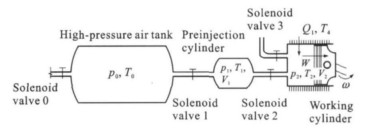Operating properties of preinjection NC air-powered engine
Article Text (Baidu Translation)
-
摘要: 为了解决传统气动发动机配气机构的密封问题, 开发一种新型预喷式数控气动发动机, 建立了它的热-动力学模型, 模型由预喷气缸与工作气缸的热-流量方程和发动机的动力学方程组成, 通过变参数动态仿真定量研究了预喷式数控气动发动机的工作过程与效率影响因素。研究结果表明: 进气结束时预喷气缸的温度约为383.5 K, 即预喷气缸期望控制压力是气动发动机的关键控制参数; 在其他参数不变的对比工况下, 设定发动机排气管电磁阀的有效流通面积分别为7.854 0×10-5、1.570 8×10-4、3.141 6×10-4m2, 此时气动发动机的效率分别为0.575 80、.777 7和0.902 2, 即排气管电磁阀的有效流通面积是影响气动发动机效率的关键因素。
-
关键词:
- 汽车工程 /
- 预喷式数控气动发动机 /
- 热-动力学模型 /
- 工作过程 /
- 效率影响因素
Abstract: To settle the seal matters in valve train system, a new preinjection NC air-powered engine was designed, its thermo-dynamics model was proposed.The model was made up of the thermo-flow rate equations of preinjection cylinder & working cylinder and the dynamics equations of the engine.The operating process and efficiency factors of the engine were quantitatively researched by varying parameter dynamic simulation.Simulation result shows that the temperature of preinjection cylinder is close to 383.5 K when air intake ends, so the key control parameter of the engine is the expected control pressure.Under comparative operating conditions, when the effective flowing area of exhaust pipe solenoid valve changes only, its values are 7.854 0×10-5, 1.570 8×10-4, 3.141 6×10-4 m2 respectively, the corresponding efficiencies of the engine are 0.575 8, 0.777 7 and 0.902 2 respectively, so the effective flowing area of exhaust pipe solenoid valve is the key efficiency factor of the engine. -
Table 1. Parameters in simulation

-
[1] LIAN Yong-qing, WANG Shu-zong, MA Shi-jie, et al. Dynamic simulation of the air-powered swashplate engine[J]. Chinese Journal of Mechanical Engineering, 2008, 44(1): 243-248. doi: 10.3901/JME.2008.01.243 [2] LIU Hao, CHEN Ying, TAO Guo-liang. Research on characteristics and model of working process of compressed-airpowered engine[J]. Progress in Natural Science, 2004, 14(3): 319-324. [3] CHEN Ping-lu, YU Xiao-li, LIU Lin. Simulation and experimental study of electro-pneumatic valve used in air-powered engine[J]. Journal of Zhejiang University: Science A, 2009, 10(3): 377-383. doi: 10.1631/jzus.A0820373 [4] LIU Lin, YU Xiao-li, HU Jun-qiang, et al. Air powered engine design based on Pareto frontier[J]. Journal of Zhejiang University: Engineering Science, 2009, 43(1): 123-127. [5] KNOWLEN C, WILLIAMS J, MATTICK A T, et al. Quasiisothermal expansion engines for liquid nitrogen automotive propulsion[J]. SAE Paper: 972649. [6] CHEN Ying, LIU Hao, TAO Gou-liang. Simulation on the port timing of an air-powered engine[J]. International Journal of Vehicle Design, 2005, 38(2/3): 259-273. doi: 10.1504/IJVD.2005.007296 [7] XU Jian-jun, LIU Hong-guang, CHEN Shi-an. The design of the power system in NC air-powered engine[J]. Chinese Hydraulics and Pneumatics, 2009, 34(3): 31-33. [8] WOOD B D. Applications of Thermodynamics[M]. 2nd. Massachusetts: Addison-Wesley Publishing Company, 1982. [9] CHEN Rui-song. Heat Transfer and Thermal Loading in Internal Combustion Engine[M]. Beijing: China Communications Press, 1988. [10] HEYWOOD J B. Internal Combustion Engine Fundamentals[M]. New York: McGraw-Hill Inc., 1988. [11] MENON S, MOULTON N, CADOU C. Development of a dynamometer for measuring small internal-combustion engine performance[J]. Journal of Propulsion and Power, 2007, 23(1): 194-202. -





 下载:
下载:











